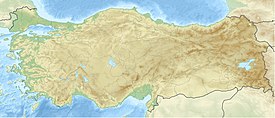| Van Fortress | |
|---|---|
| Van, Turkey | |
 Van Fortress as seen from the northwest | |
| Coordinates | 38°30′09″N 43°20′24″E / 38.50250°N 43.34000°E |
| Type | Fortress |
| Site information | |
| Open to the public | Yes |
| Condition | Large sections of walls are still standing. |
| Site history | |
| Built | 8th and 7th centuries BC |
| Materials | Unmortared basalt (lower walls) and mud-bricks |
| Demolished | Partially |
The Fortress of Van (Armenian: Վանի Բերդ, also known as Van Citadel; Kurdish: Kela Wanê; Turkish: Van Kalesi) is a massive stone fortification built by the ancient kingdom of Urartu during the 9th to 7th centuries BC, and is the largest example of its kind. It overlooks the ruins of Tushpa, the ancient Urartian capital during the 9th century, which was centered upon the steep-sided bluff where the fortress now sits. A number of similar fortifications were built throughout the Urartian kingdom, usually cut into hillsides and outcrops in places where modern-day Armenia, Turkey and Iran meet. Successive groups such as the Medes, Achaemenids, Armenians, Parthians, Romans, Sassanid Persians, Byzantines, Arabs, Seljuks, Safavids, Afsharids, Ottomans and Russians each controlled the fortress at one time or another. The ancient fortress is located just west of Van and east of Lake Van in the Van Province of Turkey.
Silva Tipple New Lake led an American expedition to the ruins in 1938-40.[1] Most of the finds and field records from this were lost in the sinking of the S.S. Athenia in 1940.
The lower parts of the walls of Van Citadel were constructed of unmortared basalt, while the rest was built from mud bricks.
Such fortresses were used for regional control, rather than as a defense against foreign armies. The ruins of this fortress sit outside the modern city of Van, where they support walls built in the medieval era.[2][full citation needed]
- ^ Who was who in America. Marquis-Who's Who. 1943. ISBN 978-0-8379-0205-0.
- ^ The Seventy Wonders of the Ancient World

